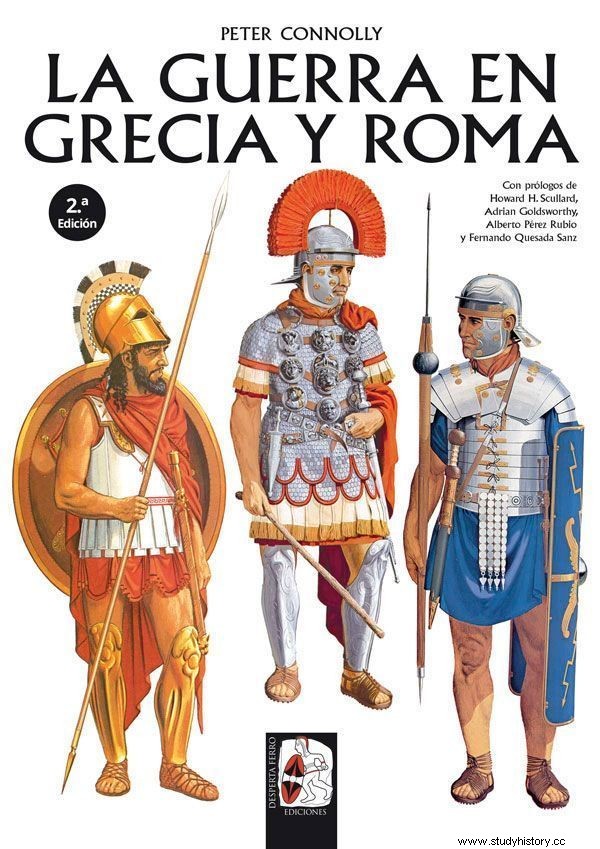
In every subject of human knowledge there are books that, for different reasons, they become “classics”. Greece and Rome at War (1981), by Peter Connolly, is undoubtedly one of them. Whoever writes these lines really does not fully understand how thirty-five years have had to pass before it has finally been translated into Spanish as The War in Greece and Rome. And this thanks to the effort and enthusiasm of the editors of Desperta Ferro, a publishing house modest in resources but enormous in intelligence. Because do not hesitate:it is a book that should be on the shelves of a lover of the classical world in any of its facets, whether amateur or professional. Peter (let me go by your first name, I met him twenty years ago) was a great guy, all the way around. When he published his first picture books at MacDonald Educational, back in 1974-1975, he was just a hugely talented illustrator. When in 1981 he published Greece and Rome at War , he caught the attention of the best ancient weapons specialists, and in 1986 he was writing high-profile academic papers at the British Museum on the development of metal breastplates in southern Italy during the Iron Age (hey!). By 1990 he was already one of the greats of experimental military archeology with his work on the Roman saddle. And since then, Peter has been a systematically invited specialist at conferences specializing in ancient weaponry. I can only regret that, committed to his last publication on the Colosseum (2003), Peter Connolly could not finish his study on the Caesarean campaigns in the vicinity of Ilerda (Lérida) that we had agreed to publish in the magazine Gladius of the Spanish CSIC, which I directed at the time. He told me in those years that his eyesight, worn by decades of meticulous drawing, already failed him. When he passed away in 2012 he was not only a member of the old and very prestigious Society of Antiquaries , but also an Honorary Research Fellow at the Institute of Archaeology, University of London. The key to the success of The war in Greece and Rome it lies in a combination, very rare in 1981, of specialized but striking illustrations made on purpose to illustrate an elegantly presented textual discourse. Images created, moreover, by the author of the text himself, who turns out to be not only an excellent specialist in weapons and classical military history, but also a gifted disseminator. This extraordinary combination of three talents in one person allowed the book to narrate in an accessible way what was then the latest in research, and to save many words by resorting to drawings that not only complemented the text, but also increased its value exponentially. be integral images to it, not additions sought with more or less success by an editorial team. Even today it is a wonderful book, in its literal sense of “extraordinary, excellent, admirable” (RAE). “Extraordinary”, because even today the complete integration of high-quality text and images (also including three-dimensional maps and all kinds of diagrams), all by the same author, is rare. “Excellent”, because Connolly managed to clearly condense an enormous amount of rigorous information of all kinds (typology of weapons, employment, tactics and strategy) in a small space. And "admirable" because even in this age of digital computer reconstructions, Peter's hand-drawn illustrations remain among the most evocative, rigorous, and illuminating ever done on the ancient world. Today – forty years later – we have splendid illustrators, perhaps even more “up-to-date” and technically superior, but I doubt that we will find anyone who does not recognize Connolly as a master, inspiration and precursor. But it is that, if we also ask specialists in war and weapons of the classical world, few would fail to cite Peter as one of the greats. Peter Connolly then published many other research papers (mainly in the scientific journals Britannia and in the Journal of Roman Military Equipment Studies ), but the work we are reviewing remains his most complete work, covering all aspects of warfare in Greece and Rome from Archaism to Late Antiquity. It is true that many years have passed, and that in some aspects the investigation has been surpassing what was known in 1981, either by adding new data or by correcting theories. But even here the editors have put a lot of effort into updating. A dense Appendix 4 with numerous almost page-by-page notes, to which is added an excellent bibliography updated up to 2014, allows the reader to appreciate the advances in research since this old but by no means obsolete classic that is La guerra en Greece and Rome . Really, if you didn't know him already, don't miss it. And someone who has written some informative books with a similar tone, perhaps more current and more dense, with more problems and less certainties, but who recognizes the inspiration that at the time, and still today, suppose the works of the great Peter Connolly.
Wake up Ferro Ancient and medieval #36 / July 2016
